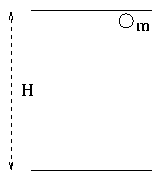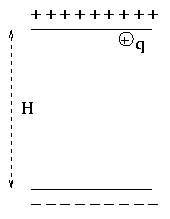 A ball of mass m is held a height H
above above a floor,
in an area where the gravitational field
points straight down with g = 9.8 m/s^2.
A ball of mass m is held a height H
above above a floor,
in an area where the gravitational field
points straight down with g = 9.8 m/s^2.
 Copyright © Michael Richmond.
This work is licensed under a Creative Commons License.
Copyright © Michael Richmond.
This work is licensed under a Creative Commons License.
 A ball of mass m is held a height H
above above a floor,
in an area where the gravitational field
points straight down with g = 9.8 m/s^2.
A ball of mass m is held a height H
above above a floor,
in an area where the gravitational field
points straight down with g = 9.8 m/s^2.
If the ball is released, it _________ because it is pulled by the ______________ force. The size of the force on the ball is ________.
As it falls, the ball gains Kinetic Energy at the expense of ____________________ Energy. How much GPE does the ball have originally? __________.
If H = 2 m and g = 9.8 m/s^2, then
a ball of mass m = 0.1 kg has GPE =
a ball of mass m = 0.5 kg has GPE =
a ball of mass m = 1.0 kg has GPE =
a ball of mass m = 3.0 kg has GPE =
The GPE of an object some distance H above the floor depends on its ___________. We can say that the GPE per unit of mass (i.e. per kilogram) is _________, which has units of ________ per _________.
We could call this quantity "Gravitational Potential Energy per Unit Mass between Floor and Ceiling", or abbreviate it to Gravitational Potential between Floor and Ceiling.
 A ball of charge q is held a height H
between two electrically charged plates,
in an area where the electric field field
points straight down with E = 3 N/C .
A ball of charge q is held a height H
between two electrically charged plates,
in an area where the electric field field
points straight down with E = 3 N/C .
If the ball is released, it _________ because it is pulled by the ______________ force. The size of the force on the ball is ________.
As it falls, the ball gains Kinetic Energy at the expense of ____________________ Energy. How much EPE does the ball have originally? __________.
If H = 2 m and E = 3 N/C , then
a ball of charge q = 0.1 C has EPE =
a ball of charge q = 0.5 C has EPE =
a ball of charge q = 1.0 C has EPE =
a ball of charge q = 3.0 C has EPE =
The EPE of an object some distance H above the negative plate depends on its ___________. We can say that the EPE per unit of charge (i.e. per Coulomb) is _________, which has units of ________ per _________.
We could call this quantity "Electric Potential Energy per Unit Charge between Positive and Negative Plate", or abbreviate it to Electric Potential between Positive and Negative Plate, or abbreviate it even more to Voltage between Positive and Negative Plate.
 Copyright © Michael Richmond.
This work is licensed under a Creative Commons License.
Copyright © Michael Richmond.
This work is licensed under a Creative Commons License.